Severe Poverty in Scotland
This report investigates the extent of severe and extreme poverty and how it has changed over time for different population groups, in the context of a decade when relative poverty has been falling in Scotland.
SECTION C: CHANGE IN THE DEPTH OF POVERTY 2002/03 TO 2012/13
Introduction
This section considers change in the depth of poverty over the ten years from 2002/03 to 2012/13. It uses the same income bands as in the previous section and again considers the whole population and population sub-groups.
Change in the depth of poverty over time for all individuals
Over the last decade, relative poverty has fallen: in 2012/13, 180,000 fewer people were in relative poverty (BHC) compared with 2002/03. More than half of this decrease was a fall in the number of people in the low income band. In 2012/13, there were 110,000 fewer people in low income than in 2002/03; 50,000 fewer people in severe low income; and 20,000 fewer people in extreme low income. The number and percentage of the population in low income, severe low income and extreme low income are available in Annex 1.
Chart 1 shows the change in the three income bands for all individuals in relative poverty, before housing costs.
Chart 1: All individuals living in relative poverty, BHC, Scotland
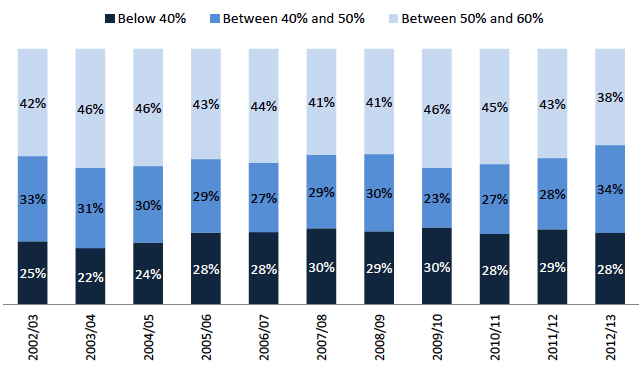
Source: HBAI datasets, DWP
The chart shows some fluctuation across the different income bands over the decade. In the most recent year, however, there was a noticeable reduction in the proportions in low income closest to the poverty threshold, from the previous year, and a corresponding increase in the proportions in severe low income.
Chart 2 presents the same data, but after housing costs have been taken into account.
Chart 2: All individuals living in relative poverty, AHC, Scotland
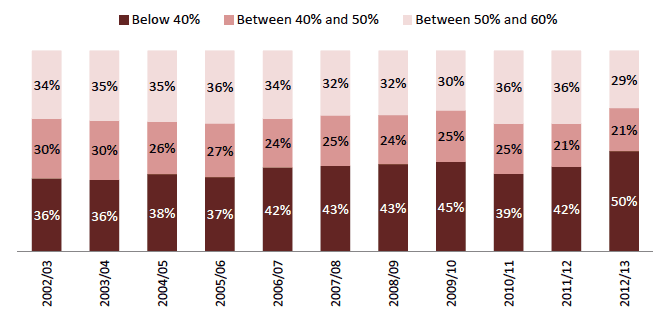
Source: HBAI datasets, DWP
The depth of poverty after housing costs again shows some variation across the decade, but also a more obvious increase in the proportion in extreme low income with a large increase in the latest year. Certainly, the picture in 2012/13 is very different from ten years previously. In 2002/03, 36 per cent of people in poverty were living in extreme low income after housing costs, compared with 50 per cent in 2012/13.
Discussion: Severe and extreme low income after housing costs
The increase in the rate of severe and extreme low income after housing costs has been more rapid than that before housing costs particularly in the latest year. Median housing costs as a ratio of median income generally decreased in Scotland between 2002/03 and 2007/08 before increasing again. However, 2012/13 saw an increase in the proportion of people in poverty in extreme low income after housing costs which was not apparent in the before housing costs measure. For those in extreme low income, households are entirely or partially reliant of benefit and tax credit income, including housing benefit. Housing benefit makes a significant contribution to household income before housing costs. However, after housing costs are deducted, disposable income is significantly lower. Housing benefit makes up 20 per cent to 50 per cent of household income, dependent on household circumstances.
There have been a number of changes to housing benefit introduced since April 2011, and the impact on the divergence between income before housing costs and after housing costs is dependent on individual households. Local Housing Allowance (LHA), which affects those in the private rented sector, determines the maximum amount of rent covered by housing benefit. In April 2011, LHA was reduced from the median (50 per cent) local rent level to 30 per cent local rent level, and national caps on LHA rates were introduced. This affected new claimants from April 2011 and existing claimants were mostly affected between January and December 2012. In addition, claimants can no longer keep the difference between their rent and the LHA rate (when rent is lower) - previously up to £15 per week. In April 2012, the age below which single people can only claim the shared-room rate increased from 25 to 35.
In 2010, across the UK, 55 per cent of tenants were renting a property that cost more than the maximum LHA entitlement, and therefore had to contribute to their own rent. Following the reforms this had increased to 62 per cent (and 68 per cent for new claimants)[1].
It appears that the impact of the changes to housing benefit have been felt by tenants rather than landlords, suggesting that the short term effect of reducing housing benefit to reduce rents has not occurred generally[2].
Further changes to housing benefit, made in April 2013, to index LHA to CPI rather than local rents, and capping of LHA increases to 1% in April 2014 and 2015, along with the introduction of the 'bedroom tax' in April 2013 for social sector tenants, could be expected to exacerbate the increases in extreme poverty after housing costs in the future.
The analysis now moves to consider the picture over time for working age adults, children and pensioners.
Change in the depth of poverty over time for working age adults
The rate of relative poverty (BHC) for working age adults in Scotland decreased by 5 percentage points between 2002/03 and 2011/12, from 18 per cent to 13 per cent, followed by an increase in 2012/13 to 15 per cent. However, working age adults experience the worst depth of poverty of the three population groups over time, particularly after housing costs. In 2012/13, over half of working age adults in poverty were in extreme low income after housing costs.
Chart 3 presents the change in income bands for this group across the decade. The depth of poverty for working age adults changed between 2002/03 and 2011/12. The proportion of working age adults in poverty living in extreme low income over this period increased; the proportion in severe low income decreased; and the proportion in low income, while it fluctuated, was largely unchanged, although it has decreased over the last three years.
Chart 3: Working age adults in relative poverty, BHC, Scotland
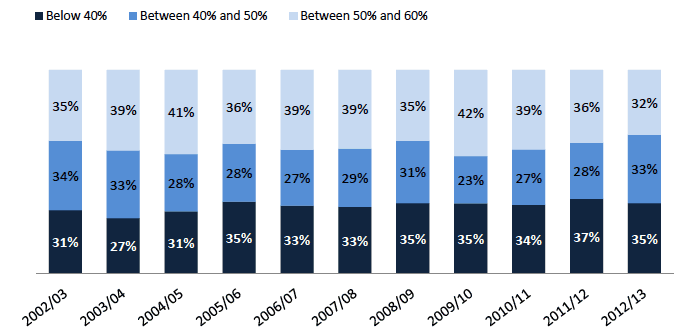
Source: HBAI datasets, DWP
In 2012/13, there was a decrease in the proportion of working age adults in poverty in the low income band (BHC), reflected by an increase those living in severe low income.
Chart 4 presents the same data, but after housing costs.
Chart 4: Working age adults in relative poverty, AHC, Scotland
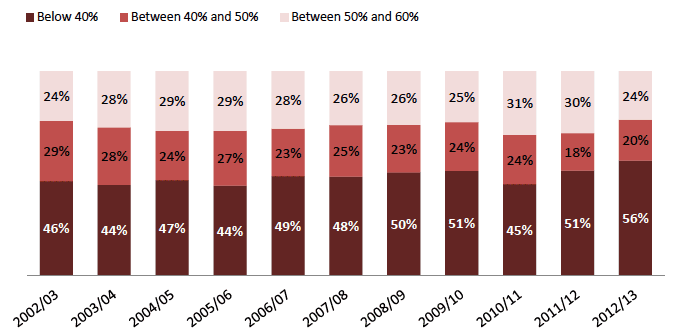
Source: HBAI datasets, DWP
After housing costs are deducted, 24 per cent of working age adults in poverty were in low income, 20 per cent were in severe low income, and 56 per cent of working age adults in poverty were living in extreme low income. Of all population groups, working age adults show the largest increases in the proportions living in extreme low income, after housing costs, in recent years.
Discussion
Over the last decade, the growth in tax credits combined with modest improvements in wages has changed the composition of working household income sources[3]. For many working age households, disposable income rose in the decade to 2008. Following the introduction of tax credits in 2003/04, the proportion of working age adults with low income increased with a corresponding decrease in the proportion in severe low income and extreme low income. However, the proportions in extreme low income were increasing again by 2004/05 and have since remained higher than they were in 2002/03. In 2012/13 tightening of eligibility to tax credits, freezing some elements of benefits, changes to local housing allowance, along with low growth in earned income have resulted in a fall in median incomes for working age households, particularly for working age households with children.
Employment is the key driver for increasing household income, and while employment remains the best route out of poverty, it is no longer a protection against poverty. The capacity to move out of poverty is dependent on the rates of pay, the hours worked and the effects of the tax and benefit system. While the number and percentage of below national minimum wage jobs in Scotland decreased[4] in 2013, 19 per cent of employees in Scotland were paid less than the Living Wage.[5]
Household income depends on family type, and the number of working age adults in the household. Single adult households have a higher risk of poverty, and the proportion of 'widowed, separated or divorced' people is around three times higher among those in poverty (24 per cent) than those outside poverty (7 per cent). Half of workers who are in poverty despite not being low-paid have children. For those not in low paid employment, with children, income needed to achieve the same standard of living is higher than for those without children. Equivalising income for family size results in these families with children, often with only one adult in employment, being in poverty. For low-paid workers who escape poverty this figure is under one third.
Historically, earnings have tended to rise in real terms and outstrip price-indexed benefit rates, boosting household incomes. However, welfare reforms made since May 2010 are likely to have had a negative impact on the lowest income households[6]. By limiting rises in the value of most working-age benefits to 1 per cent for three years, as opposed to linking their increases to inflation, the amount of support given to low-income households in real terms will fall significantly. By 2017/18, reforms to personal taxes made in the 2012 Autumn Statement will provide the greatest benefit to those on middle incomes, but will not reverse the impact of real cuts to welfare. For households in the middle of the income distribution, the increase in the personal allowance will provide a small increase to incomes, but the poorest households gain less from this change.[7]
Change in the depth of poverty over time for children
Over the decade to 2012/13, the rate of relative poverty for children in Scotland saw a similar decline to that of working age adults, decreasing by 5 percentage points from 24 per cent in 2002/03 to 19 per cent in 2012/13. However, the picture as regards the depth of poverty for children is somewhat different. Children in poverty are less likely to be in the extreme low income band before and after housing costs and are more likely to be in the low income band before and after housing costs than working age adults.
Chart 5 below highlights that, over the period, around half of children in poverty were in the low income band just below the poverty threshold. In the latest year, this proportion has fallen, with a corresponding increase in the proportion in the severe low income band.
Chart 5: Children in relative poverty, BHC, Scotland
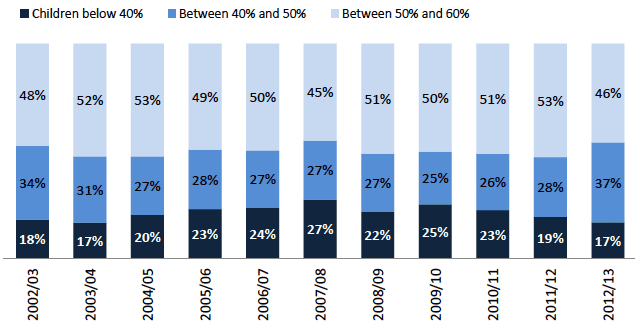
Source: HBAI datasets, DWP
The proportion of children in poverty in the extreme low income band increased slowly until 2007/08, before decreasing since then. Nevertheless, in 2012/13, 17 per cent of children in poverty were in extreme low income. This equates to household income (before housing costs) of less than £269 per week for a couple with two children and £211 per week for a single parent with two children.
Chart 6 presents the same data, but after housing costs.
Chart 6: Children in relative poverty, AHC, Scotland
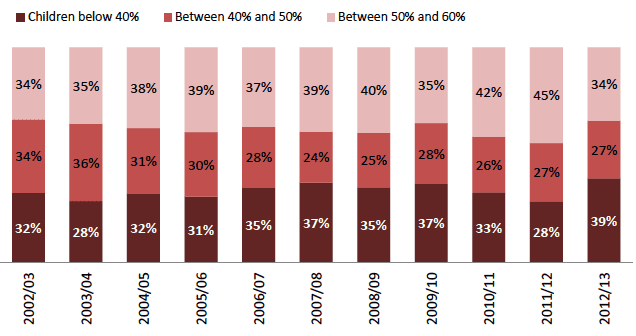
Source: HBAI datasets, DWP
After housing costs are accounted for, the proportion of children in poverty in the low income band was lower than before housing costs, but for most years, there were more children in this than other bands. However, in 2012/13, the proportion of children living in the low income band fell sharply to 34 per cent from 45 per cent in 2011/12, while the proportion in extreme low income rose to 39 per cent (from 28 per cent). The proportion in severe low income was unchanged in the latest year at 27 per cent.
For families with children, those in poverty are more reliant on benefit income to maintain household income, even if one or both of the adults are in employment. For example, housing benefit contributes around a third of household income for an unemployed single parent family, and around 22 per cent of household income for a single parent family in part time employment. For unemployed couple families, housing benefit contributes around 30 per cent of household income and 13 per cent if one adult is in full time employment[8]. After housing costs, disposable income is significantly lower for many families.
Discussion
For families with children, the positive impacts of tax credits (introduced in 2003/04) increased household incomes relative to households without children. This is reflected in the charts above, with the shift in the proportion of children in poverty from severe low income to low income households. While tax credits have had a positive impact on the group, increasing household incomes, the percentage of children in extreme low income before housing costs generally increased to 2007/08, before decreasing to 17 per cent in 2012/13. Children in families in extreme low income are significantly more likely to be living in households where benefit income is the sole source of income. Up to 2010/11, some benefits relating to children were uprated at a faster rate than other benefits; however these increases were still not as large as the increase in average earnings in real terms.
Employment is the key driver for increasing household income in families with children. Employment remains the best route out of poverty, but it is no longer a protection against poverty. Depending on the hours worked, this is enough to increase income, but not to levels to move the family out of poverty. If employment is low paid (at or below national minimum wage) even full time employment would not lift a single parent family out of poverty.
While employment does reduce the risk of severe and extreme poverty for families with children, where employment is low paid, or part time, families remain reliant on benefit and tax credit income to raise household income to levels close to the poverty threshold.
For families in employment, much of the fall in poverty was due to an increase in employment rates for lone parents, and to an increase in employment rate for couple families, as more couple families moved into full employment (where both adults were in employment). However, in 2012/13, reduced eligibility for in-work tax credits has contributed to a fall in household income for those with lower earnings who were unable to increase the number of hours worked. In addition, other changes to benefits and tax credits in April 2012[9], have affected household income for families with children.
For single parents, opportunities for employment as a route out of poverty are more limited. Over the last decade the employment rate for lone parents has increased[10]. However, analysis shows the work that lone parents had done since leaving income support was generally low-skilled work at around the national minimum wage. Nearly all were working part-time. And while lone parents who had entered work or increased their hours were less likely to be in material deprivation and on low income, nearly four in ten remained in low income and material deprivation.[11]
For couple families, the move to full employment can increase income enough to move above the poverty threshold. Again, it is hours worked and pay rates that determine whether a family can raise income enough to increase household income above the poverty threshold. Based on the tax and welfare reforms in place in 2012/13, single parent families remain reliant on benefit and tax credit income to raise household income beyond the poverty threshold[12]. For a couple with one adult in full time employment and one adult in part time employment on low pay, earnings make up around three quarters of household income needed to meet the poverty threshold. Increasing the hourly rate of pay, and moving both adults into full time employment would allow the household income to increase beyond the poverty threshold[13].
For families not in employment, there is little opportunity to increase income. Households in the bottom three income deciles are significantly more likely to be dependent on benefit income as the only source of income. Over the period, while increases to some benefits relating to families with children were uprated at a faster rate than other benefits, these increases were still not as large as the increase in average earnings in real terms. However since 2010/11, low wage growth has meant benefits have increased faster than earned income, reflected in the fall in the proportion of children in poverty living in extreme poverty households in these two years. However, poverty rates for children in workless families in Scotland remains high[14].
In the last two years, low wage growth, combined with welfare reform, has contributed to the increase in the proportion of children living in severe low income, while the proportion in extreme low income has seen a decrease in the last two years. Prior to the recession, average earnings increased faster than benefit income, meaning families with children who were in employment were more able to increase household income relative to families who were not in employment.
This indicates policies to improve the incomes of the poorest children, while improving the financial circumstances of the less poor, have not had a positive impact on reducing the rate of extreme child poverty. It is these families with children at the bottom of the income distribution who are less likely to be in employment (or full employment), and who may face additional barriers to the labour market, who are least able to increase household incomes and move up the income distribution.
Change in the depth of poverty over time for pensioners
Between 2002/03 and 2011/12, relative pensioner poverty has decreased nearly 10 percentage points from 23 per cent to 14 per cent, followed by a small increase to 15 per cent in 2012/13. Analysis of the depth of poverty suggests that pensioners in poverty are more likely to be in the low income band closest to the poverty threshold, particularly after housing costs are taken into account. Of the three population groups considered in this analysis, pensioners were the least likely to live in severe or extreme poverty, particularly after housing costs.
Charts 7 shows change in the depth of pensioner poverty over time, before costs.
Chart 7: Pensioners in relative poverty, BHC, Scotland
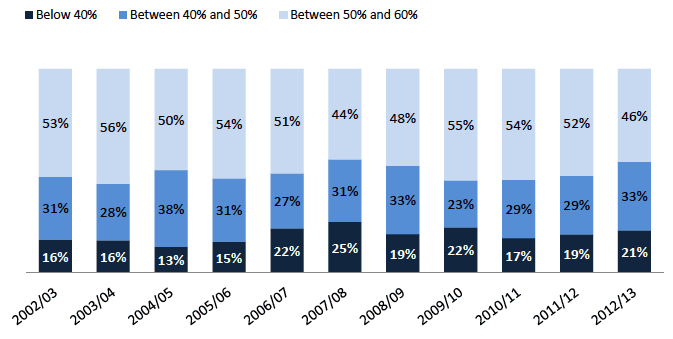
Source: HBAI datasets, DWP
The chart shows that, over the last decade, around half of pensioners living in poverty (BHC) were in households with incomes just below the poverty threshold. Nevertheless it is still noteworthy that, in 2012/13, 21 per cent of pensioners in poverty were in the extreme low income band (£176 per week for a pensioner couple, and £118 per week for a single pensioner). The proportion of pensioners in poverty living in extreme low income has fluctuated over the last decade reaching 25 per cent in 2007/08 before falling to 17 per cent in 2010/11, with small increases in the last two years. The proportion of pensioners in extreme low income (BHC) in 2012/13 remains significantly higher than in 2002/03.
Chart 8 presents the same information, but after housing costs.
Chart 8: Pensioners in relative poverty, AHC, Scotland
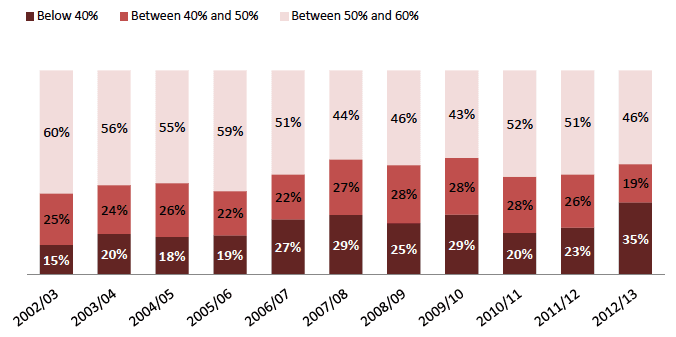
Source: HBAI datasets, DWP
After housing costs there has been a large increase in the proportion of pensioners in poverty in extreme low income - an increase from 23 per cent in 2011/12 to 35 per cent in 2012/13.
There are a number of reasons why the depth of poverty for pensioners overall looks better than for other groups. First, taking a longer view, pensioner incomes have grown faster than average earnings across the economy as a whole since 1998-99 and net income after housing costs has grown more quickly. This is partly due to the fact that pensioners are now more likely to own their home outright than they were in 1998-99, and so have lower housing costs[15] [16]. Pensioners in the middle of the income distribution have seen faster growth than those in the upper end of the distribution.
Second, more recently, the rate of increase in the Basic State Pension has been higher than average earnings increases since 2009, which means pensioner income has increased faster than income for working age families, and at a faster rate than for most other benefit and tax credit income. The introduction of Pension Credit in 2003, which guarantees a minimum income for pensioners, has had a large impact in maintaining pensioner minimum income. However, take up rates remain below 80 per cent for the Guarantee Credit only in 2010[17].
There are, of course, differences in the depth of poverty in terms of different groups of pensioners.
Pensioner couples are less likely to be in extreme low income. Pensioner couples on average have around two-and-a-half times the level of occupational pensions and approximately three times the amount of investment income as single pensioners. Benefit income makes up less than half of all income for pensioner couples, while it makes up over 70 per cent of income for single pensioners.[18].
Older pensioners (aged 75 or older) on average have lower incomes across all pensioner age groups. Higher earnings and higher private pension income are the main sources of difference between younger and older pensioners' incomes. For the 75 or over group, the lack of earnings means that a greater proportion of gross income comes from benefits.
Female pensioners on average have lower incomes across all pensioner age groups. The main difference between the genders occurs for occupational pension income. In 2010-11, single men received £99 per week on average from this source, compared with £61 per week for single women[19]. Single men also received more investment and personal pension income, while average incomes from other sources were more consistent for single men and women.
Contact
Email: Stephen Smith
There is a problem
Thanks for your feedback